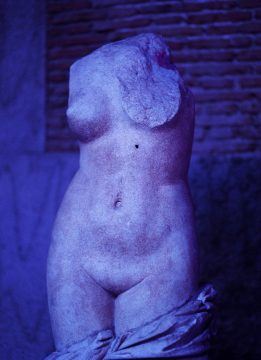by Timothy Don
The current economic crisis is crushing artists, museums, and galleries everywhere. In the San Francisco Bay Area, where I live, an exorbitant rental market made maintaining a practice difficult before this crisis hit. It’s even harder now. With 3QD’s permission, I’m going to use this column to talk about the work of some of the artists and art professionals I have met in the Bay Area. I ask you to support artists wherever you find them and however you can.

Roman Women XIII, by Sara VanDerBeek, 2013. Digital c-print, 66 x 47 3/4 in. From the series Roman Women.
A digitally manipulated and synthetically colored contemporary photograph of a sculptural object from classical-era Rome, this piece looks at first glance like a picture postcard, memento of a delightful afternoon spent at the Vatican museum. Look more closely, however: in subject matter and method, the work addresses and bridges in one stroke both the ancient world and our present moment. It projects the textures and patinas of the past onto the flat screens of the present, and it resituates that present as a way station on the journey through time of images and ideas, meanings and ideologies. It is both art and artifact.
We have become accustomed over the last several hundred years to an image of antiquity hewn from white marble: clean, harmonious, and transcendent; conceptually pure, flawlessly executed. In a word: Classical. Recent historical research, however, suggests that Roman statuary, along with the Greek originals that it copied, was polychromatic, embellished, and almost luridly vibrant. Sara VanDer Beek recalls this aspect of classical art by saturating her photograph with a shade of violet approaching Tyrian purple. She reminds us that classical doesn’t mean white. Classical was colorful.
Her aim, however, is not merely to introduce visual facticity to the historical record. This is a photograph of a copy of a lost original. It is the top layer in a stack of reproducible objects, evidence of the layering effect of and through which history is composed. This picture is then-and-now, uniquely contemporary in its utilization of present-day technologies of representation, archival in its reinscription of that technology within a geneology of visual representation dating back to the birth of western civilization. This piece accomplishes the same movement (from past to present and back again) with regard to its subject matter: the human female form.
When we feel the urge to contemplate in sublime rapture the beauty and perfection of classical sculpture, it is worth remembering that Roman statues of the sort photographed by the artist were themselves copies produced en masse of Greek work from 500 years prior. Furthermore, these reproductions were deployed by the Roman state across its empire as a form of visual propaganda that, over the intervening millennia, has come to define the ideal female form. In other words, and like an echo or an analogue to their expanding geographical borders, the Romans projected through time and by means of their “art” an ideology of the human female form that has shaped modern conceptions of femininity and the ideal female body. Photography, of course, has picked up and deepened that ideology, in everything from advertising to pornography. This piece reminds us that (where means and media are concerned) propaganda does not discriminate.
And so this photograph, in its massive materiality and thematic density, collapses the distinction between sculpture and photography. In its recapitulation of classical ideals, it places on the scale the immaterial notions of beauty by which the female form has been weighed down. In its sublime stillness and gorgeous hue, it captures the ever-blurring lines between art and propaganda. Simultaneously present and ancient, it brings to mind Faulkner’s observation: “The past is never dead. It’s not even past.”
Sara VanDer Beek is represented in San Francisco by Altman Siegel, www.altmansiegel.com
